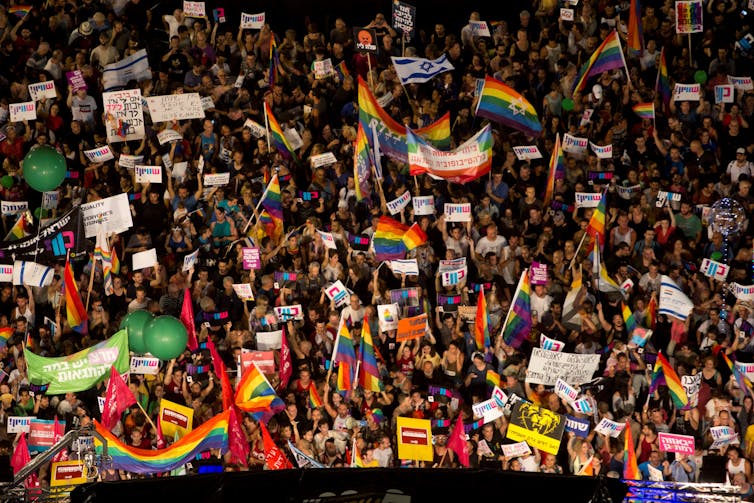(The Conversation) — American Jews donate at high levels to charity. One way they support causes in the U.S., Israel and other places is collective, often through large grant-making organizations.
In researching this organized philanthropy, I’ve observed that the proportion of Jewish institutional giving to Israeli causes has fallen since 2009. I believe that several factors, including demographic and social changes, a diminishing perception of Israel as being in need and concerns over the Palestinian-Israeli conflict have probably been driving this decline for years.
More recently, Israel’s increasingly conservative policies on social and religious issues, which are often at odds with what most American Jews support, might also be playing a role.
A tradition of support
American Jews proved a major source of philanthropic support for the Israeli state and Israeli society throughout the 20th century. A network of Jewish fundraising and advocacy groups have long organized collective donations and lobbying efforts.
These groups make major donations to large Israeli nonprofits, like the Jewish Agency for Israel and the Joint Distribution Committee, which then distribute them to smaller, local nonprofits.
However, knowledge about the actual scope of Jewish philanthropic contributions to Israel is limited. Data collected by my colleagues at Brandeis University indicate a steady increasefrom $1.05 billion annually in 1975 to $2.05 billion in 2007 in real dollars.
And data from the Israeli Central Bureau of Statistics indicate that charitable gifts to organizations in Israel, from sources in the U.S. and other foreign countries, kept growing – rising from $1.95 billion in 2009 to $2.91 billion in 2015.
A smaller share
I am conducting a study with a colleague at Brandeis University, Matthew Brookner, in collaboration with the Institute for Law and Philanthropy at Tel Aviv University. Together, we are exploring patterns and trends in Jewish grant-making to Israeli causes that have not been completely understood until now.
To understand Jewish giving to Israel we mined data using the Foundation Search database, which provided us with large amounts of digitized financial information.
Federations and foundations
To see what’s changing in this kind of giving, we split the data into large grants over $500,000 and smaller grants. Our initial findings are based on an analysis of 21,062 large grants allocated by 1,235 Jewish funding organizations between 2000 and 2015, totaling $46.3 billion.
We found that the total scope of donations for Israel grew between 2000 and 2015. While more money is contributed to Israeli causes, the share of Jewish giving going to Israel from the overall contributions – which also includes Jewish causes outside Israel and non-Jewish charities – has declined.
Among other things, we found that the top funding organizations to Israeli causes are still Jewish Federations, communal fundraising institutions that operate in most North American metropolitan areas. These federations gave Israeli causes a total of $2.3 billion between 2000 and 2015.
But giving from private foundations and pass-through organizations – intermediaries that transfer donations to other groups – now rivals that revenue source. Those kinds of donors provided $2.2 billion in support each during this period.
Two-thirds of the grants supporting Israeli causes were allocated to U.S.-based organizations, such as Friends of the Israel Defense Forces. We also found the peaks we expected to see in large grants for Israeli causes in the years 2002 and 2003, 2006 through 2008 and 2011.
These upswings coincided with major events including the Second Intifada, the Second Lebanon War and the conflict in Gaza in 2008 and 2009.
Giving fell, however, following the Great Recession. The single point of divergence in this time followed the devastating 2010 Mount Carmel forest fire near the Israeli city of Haifa.
Change of pace
Although American Jews still donate more to Israel amid wartime emergencies, we did not see similar spikes in giving following a major military operation in Gaza in 2012 or in 2014 when the conflict in Gaza flared again.
And overall, the proportion of Jewish giving going to Israeli causes as a share of donations is decreasing as is the share of giving to non-Jewish causes. Meanwhile, giving to Jewish causes outside Israel is rising.
In fact, only 9 percent of organized Jewish giving was allocated to Israeli causes in 2015. In comparison, 58 percent supported non-Jewish causes and 32 percent backed Jewish causes outside Israel.
This decrease in the share of giving for Israeli causes was evident as early as 2009, excluding the surge in donations in 2011 driven by the Mount Carmel forest fire.
A growing divide
Explaining this decrease in donations should acknowledge the existence of political, economic and demographic trends impacting U.S. Jewish philanthropy. In addition, Israel is becoming by many measures more socially, politically and religiously conservative, exacerbating points of contention between many U.S. Jews, who are more likely to be liberalthan conservative, and Israel.
Among the deepest disagreements is what conversion to Judaism should require to be recognized by Israel’s government – which has repercussions in terms of which foreign Jews have a right to immigrate to Israel and live there as citizens.
After the question of “Who is a Jew?” had been hotly debated in the U.S. and Israel for more than three decades, the Knesset – Israel’s parliament – granted the Chief Rabbinate, a government ultra-Orthodox establishment, a monopoly over the conversion process to Judaism in the summer of 2017.
This move excluded Reform, Conservative and Reconstructionist conversions altogether, raising objections from American Jewish leaders. Although Israel subsequently delayed the bill’s enactment, the criticism voiced by many American Jews has not abated.
Another source of friction between the world’s two largest Jewish communities is the ongoing efforts of non-Orthodox Jewish denominations to create a prayer space shared by women and men at the Western Wall, a holy site in Israel.
President Donald Trump’s policies toward Israel have aggravated this divide, especially due to his decision to move the U.S. embassy to Jerusalem from Tel Aviv.
More erosion ahead
Israel’s increasingly conservative social and religious policies may be gradually eroding Jewish philanthropic support for Israeli causes.
I believe this trend will only grow, following the passage of a new surrogacy law that instituted state support for surrogacy pregnancies – excluding gay men seeking to become fathers.
Another contentious law may have an even deeper impact. It declared that Jewish people have the exclusive right to self-determination in Israel. Its passage brought on massive demonstrations in Israel and elicited objections from some of the most prominent American Jewish organizations.
(Hanna Shaul Bar Nissim is a postdoctoral fellow at the Maurice and Marilyn Cohen Center for Modern Jewish Studies, Brandeis University. This article was originally published on The Conversation)










